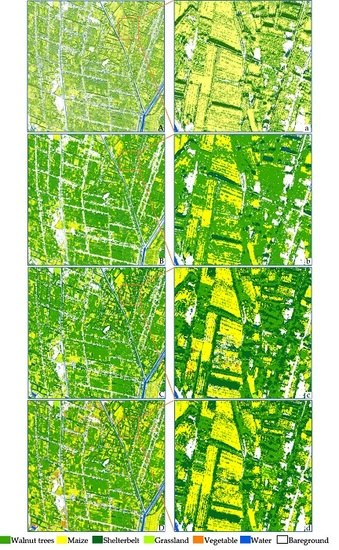Intercropping Classification From GF-1 and GF-2 Satellite Imagery Using a Rotation Forest Based on an SVM
Abstract
:1. Introduction
2. Study Area and Data
2.1. Study Area
2.2. Field Sampling
2.3. Remote Sensing Data Pre-processing
3. Methodology
3.1. Feature Selection
- F1. Spectral features of GF-2 images, which include fused multi-spectral GF-2 images (features 1–4 in Table 2).
- F2. Multisource information of GF-2 images, including F-1 and textural features (features 1–36 in Table 2).
- F3. Multi-temporal and multisource information, including the F2 and GF1 NDVI, EVI GF2 NDVI, and EVI (features 1–42 in Table 2).
3.2. Intercropping Classification
- Input the initial sample set , which includes n features, and the number of base classifiers L.
- Randomly divide into equally sized subsets: where features were obtained from each subset. When the number of features is not divisible, the remaining features are added to the last subset of features.
- Process subsets as follows:
- 1)
- Let be the -th subset of features used to train the -th classifier, . Let be the sample set with only features involved in subset . This subset can be viewed as a reduced-dimension dataset of original set and thus as an matrix where is the number of features in subset . Then, apply the bootstrap method is to to obtain new sample subset .
- 2)
- Perform a principal component analysis (PCA) of to calculate coefficients of the principal components.
- 3)
- Repeat Steps 1 and 2 and organize the obtained principal component coefficients into a matrix :
- 4)
- Rearrange to obtain rotation matrix and generate new sample set = .
- 5)
- Select as the base classifier (SVM is adopted in this study) to obtain an ensemble classifier () and then return to Step 2, loop times, and obtain the ensemble classifier [20].
- 6)
- Let be the sample to be classified and is the probability of classifier determining that sample belongs to the -th class. Then, the credibility of the sample assigned to a certain category is defined as Equation (4), which is adapted from [20]:Again, is the number of base classifiers, and is the number of categories (classes). Sample belongs to the category of maximal reliability.
4. Results and Analysis
4.1. RoF Parameter Setting
4.2. Comparison of Different Feature Combinations
4.3. Comparisons with Other Classifications
5. Conclusions
Author Contributions
Funding
Acknowledgements
Conflicts of Interest
References
- Food and Agriculture Organization of the United Nations. Available online: http://www.fao.org/forestry/agroforestry/en/ (accessed on 1 August 2018).
- Smith, J.; Pearce, B.D.; Wolfe, M.S. Reconciling productivity with protection of the environment: Is temperate agroforestry the answer? Renew. Agric. Food Syst. 2013, 28, 80–92. [Google Scholar] [CrossRef]
- Wolz, K.J.; DeLucia, E.H. Alley cropping: Global patterns of species composition and function. Agric. Ecosyst. Environ. 2018, 252, 61–68. [Google Scholar] [CrossRef]
- Suroshe, S.S.; Chorey, A.B.; Thakur, M.R. Productivity and economics of maize-based intercropping systems in relation to nutrient management. Res. Crop. 2009, 10, 38–41. [Google Scholar]
- Waldner, F.; Canto, G.S.; Defourny, P. Automated annual cropland mapping using knowledge-based temporal features. ISPRS J. Photogramm. Remote Sens. 2015, 110, 1–13. [Google Scholar] [CrossRef]
- Begue, A.; Arvor, D.; Bellon, B.; Betbeder, J.; de Abelleyra, D.; Ferraz, R.P.D.; Lebourgeois, V.; Lelong, C.; Simoes, M.; Veron, S.R. Remote Sensing and Cropping Practices: A Review. Remote Sens. 2018, 10, 99. [Google Scholar] [CrossRef]
- Pringle, M.J.; Schmidt, M.; Tindall, D.R. Multi-decade, multi-sensor time-series modelling-based on geostatistical concepts-to predict broad groups of crops. Remote Sens. Environ. 2018, 216, 183–200. [Google Scholar] [CrossRef]
- Waldner, F.; Lambert, M.-J.; Li, W.; Weiss, M.; Demarez, V.; Morin, D.; Marais-Sicre, C.; Hagolle, O.; Baret, F.; Defourny, P. Land Cover and Crop Type Classification along the Season Based on Biophysical Variables Retrieved from Multi-Sensor High-Resolution Time Series. Remote Sens. 2015, 7, 10400–10424. [Google Scholar] [CrossRef]
- Belgiu, M.; Csillik, O. Sentinel-2 cropland mapping using pixel-based and object-based time-weighted dynamic time warping analysis. Remote Sens. Environ. 2018, 204, 509–523. [Google Scholar] [CrossRef]
- Hartfield, K.A.; van Leeuwen, W.J.D. Woody Cover Estimates in Oklahoma and Texas Using a Multi-Sensor Calibration and Validation Approach. Remote Sens. 2018, 10, 632. [Google Scholar] [CrossRef]
- Culvenor, D.S. TIDA: An algorithm for the delineation of tree crowns in high spatial resolution remotely sensed imagery. Comput. Geosci. 2002, 28, 33–44. [Google Scholar] [CrossRef]
- Mayossa, P.K.; D’Eeckenbrugge, C.; Borne, F.; Gadal, S.; Viennois, G. Developing a method to map coconut agrosystems from high-resolution satellite images. Proceedings of International Cartographic Conference, Rio de Janeiro, Brazil, 23–25 August 2015. [Google Scholar]
- China Centre for Resources Satellite Data and Application. Available online: http://www.cresda.com/EN/ (accessed on 1 December 2017).
- Chinese GF Application Integrated Information Service Sharing Platform. Available online: http://gfplatform.cnsa.gov.cn/ (accessed on 10 October 2017).
- Zhou, Q.-B.; Yu, Q.-Y.; Liu, J.; Wu, W.-B.; Tang, H.-J. Perspective of Chinese GF-1 high-resolution satellite data in agricultural remote sensing monitoring. J. Integr. Agric. 2017, 16, 242–251. [Google Scholar] [CrossRef]
- Jia, K.; Liang, S.; Gu, X.; Baret, F.; Wei, X.; Wang, X.; Yao, Y.; Yang, L.; Li, Y. Fractional vegetation cover estimation algorithm for Chinese GF-1 wide field view data. Remote Sens. Environ. 2016, 177, 184–191. [Google Scholar] [CrossRef]
- Arun, P.V.; Buddhiraju, K.M.; Porwal, A. CNN based sub-pixel mapping for hyperspectral images. Neurocomputing 2018, 311, 51–64. [Google Scholar] [CrossRef]
- Sonobe, R.; Yamaya, Y.; Tani, H.; Wang, X.; Kobayashi, N.; Mochizuki, K.-I. Crop classification from Sentinel-2-derived vegetation indices using ensemble learning. J. Appl. Remote Sens. 2018, 12. [Google Scholar] [CrossRef]
- Rodriguez-Galiano, V.F.; Chica-Olmo, M.; Abarca-Hernandez, F.; Atkinson, P.M.; Jeganathan, C. Random Forest classification of Mediterranean land cover using multi-seasonal imagery and multi-seasonal texture. Remote Sens. Environ. 2012, 121, 93–107. [Google Scholar] [CrossRef]
- Rodriguez, J.J.; Kuncheva, L.I. Rotation forest: A new classifier ensemble method. IEEE Trans. Pattern Anal. Mach. Intell. 2006, 28, 1619–1630. [Google Scholar] [CrossRef] [PubMed]
- Du, P.; Samat, A.; Waske, B.; Liu, S.; Li, Z. Random Forest and Rotation Forest for fully polarized SAR image classification using polarimetric and spatial features. ISPRS J. Photogramm. Remote Sens. 2015, 105, 38–53. [Google Scholar] [CrossRef]
- Lv, F.; Han, M. Hyperspectral Image Classification Based on Improved Rotation Forest Algorithm. Sensors 2018, 18, 3601. [Google Scholar] [CrossRef]
- Kussul, N.; Lavreniuk, M.; Skakun, S.; Shelestov, A. Deep Learning Classification of Land Cover and Crop Types Using Remote Sensing Data. IEEE Geosci. Remote Sens. Lett. 2017, 14, 778–782. [Google Scholar] [CrossRef]
- Huang, X.; Hu, T.; Li, J.Y.; Wang, Q.; Benediktsson, J.A. Mapping Urban Areas in China Using Multisource Data With a Novel Ensemble SVM Method. IEEE Trans. Geosci. Remote Sens. 2018, 56, 4258–4273. [Google Scholar] [CrossRef]
- Krawczyk, B.; Minku, L.L.; Gama, J.; Stefanowski, J.; Wozniak, M. Ensemble learning for data stream analysis: A survey. Inf. Fusion 2017, 37, 132–156. [Google Scholar] [CrossRef]
- Lin, L.; Zuo, R.; Yang, S.; Zhang, Z. SVM ensemble for anomaly detection based on rotation forest. Proceedings of Third International Conference on Intelligent Control and Information Processing, Dalian, China, 15–17 July 2012; pp. 150–153. [Google Scholar]
- Statistics Bureau of Xinjiang Uygur Autonomous Region. Available online: http://www.xjtj.gov.cn/sjcx/tjnj_3415/2016xjtjnj/ny/201707/t20170714_539607.html (accessed on 11 January 2019).
- Wang, J.; Wusiman, A.; Yusupu, A.; Aiqiong, W.U.; Xia, J.; Zhang, D.J. Analysis about Wheat Growth and Yield Formation in Walnut/Wheat Intercropping System. Acta Agriculturae Boreali-occidentalis Sinica. 2016, 25, 1289–1296. [Google Scholar]
- Wang, Q.; Blackburn, G.A.; Onojeghuo, A.O.; Dash, J.; Zhou, L.; Zhang, Y.; Atkinson, P.M. Fusion of Landsat 8 OLI and Sentinel-2 MSI Data. IEEE Trans. Geosci. Remote Sens. 2017, 55, 3885–3899. [Google Scholar] [CrossRef]
- Yokoya, N.; Grohnfeldt, C.; Chanussot, J. Hyperspectral and Multispectral Data Fusion A comparative review of the recent literature. IEEE Geosci. Remote Sens. Mag. 2017, 5, 29–56. [Google Scholar] [CrossRef]
- Liu, J.; Huang, J.Y.; Liu, S.G.; Li, H.L.; Zhou, Q.M.; Liu, J.C. Human visual system consistent quality assessment for remote sensing image fusion. ISPRS J. Photogramm. Remote Sens. 2015, 105, 79–90. [Google Scholar] [CrossRef]
- Shao, Z.F.; Cai, J.J. Remote Sensing Image Fusion With Deep Convolutional Neural Network. IEEE J. Sel. Top. Appl. Earth Observ. Remote Sens. 2018, 11, 1656–1669. [Google Scholar] [CrossRef]
- Zhou, X.; Liu, J.; Liu, S.; Cao, L.; Zhou, Q.; Huang, H. A GIHS-based spectral preservation fusion method for remote sensing images using edge restored spectral modulation. ISPRS J. Photogramm. Remote Sens. 2014, 88, 16–27. [Google Scholar] [CrossRef]
- Gasparovic, M.; Jogun, T. The effect of fusing Sentinel-2 bands on land-cover classification. Int. J. Remote Sens. 2018, 39, 822–841. [Google Scholar] [CrossRef]
- Gašparović, M.; Medak, D.; Pilaš, I.; Jurjević, L.; Balenović, I. Fusion of sentinel-2 and planetscope imagery for vegetation detection and monitoring. Int. Arch. Photogramm. Remote Sens. Spat. Inf. Sci. 2018, XLII-1, 155–160. [Google Scholar] [CrossRef]
- Maurer, T. How to pan-sharpen images using the Gram-Schmidt pan-sharpen method—A recipe. Int. Arch. Photogramm. Remote Sens. Spat. Inf. Sci. 2013, XL-1/W1, 239–244. [Google Scholar] [CrossRef]
- Roy, D.P.; Kovalskyy, V.; Zhang, H.K.; Vermote, E.F.; Yan, L.; Kumar, S.S.; Egorov, A. Characterization of Landsat-7 to Landsat-8 reflective wavelength and normalized difference vegetation index continuity. Remote Sens. Environ. 2016, 185, 57–70. [Google Scholar] [CrossRef]
- Huett, C.; Koppe, W.; Miao, Y.; Bareth, G. Best Accuracy Land Use/Land Cover (LULC) Classification to Derive Crop Types Using Multitemporal, Multisensor, and Multi-Polarization SAR Satellite Images. Remote Sens. 2016, 8, 684. [Google Scholar] [CrossRef]
- Baret, F.; Clevers, J.; Steven, M.D. The Robustness of Canopy Gap Fraction Estimates From Red And Near-Infrared Reflectances—A Comparison Of Approaches. Remote Sens. Environ. 1995, 54, 141–151. [Google Scholar] [CrossRef]
- Jiang, Z.; Huete, A.R.; Didan, K.; Miura, T. Development of a two-band enhanced vegetation index without a blue band. Remote Sens. Environ. 2008, 112, 3833–3845. [Google Scholar] [CrossRef]
- Bolton, D.K.; Friedl, M.A. Forecasting crop yield using remotely sensed vegetation indices and crop phenology metrics. Agric. For. Meteorol. 2013, 173, 74–84. [Google Scholar] [CrossRef]
- Huete, A.; Didan, K.; Miura, T.; Rodriguez, E.P.; Gao, X.; Ferreira, L.G. Overview of the radiometric and biophysical performance of the MODIS vegetation indices. Remote Sens. Environ. 2002, 83, 195–213. [Google Scholar] [CrossRef]
- Huang, X.; Liu, X.B.; Zhang, L.P. A Multichannel Gray Level Co-Occurrence Matrix for Multi/Hyperspectral Image Texture Representation. Remote Sens. 2014, 6, 8424–8445. [Google Scholar] [CrossRef]
- Wang, T.; Zhang, H.S.; Lin, H.; Fang, C.Y. Textural-Spectral Feature-Based Species Classification of Mangroves in Mai Po Nature Reserve from Worldview-3 Imagery. Remote Sens. 2016, 8, 15. [Google Scholar] [CrossRef]
- Lan, Z.Y.; Liu, Y. Study on Multi-Scale Window Determination for GLCM Texture Description in High-Resolution Remote Sensing Image Geo-Analysis Supported by GIS and Domain Knowledge. ISPRS Int. Geo-Inf. 2018, 7, 24. [Google Scholar] [CrossRef]
- Xiu, Y.; Liu, W.; Yang, W. An Improved Rotation Forest for Multi-Feature Remote-Sensing Imagery Classification. Remote Sens. 2017, 9, 1205. [Google Scholar] [CrossRef]
- Belgiu, M.; Dragut, L. Random forest in remote sensing: A review of applications and future directions. ISPRS J. Photogramm. Remote Sens. 2016, 114, 24–31. [Google Scholar] [CrossRef]
- Georganos, S.; Grippa, T.; Vanhuysse, S.; Lennert, M.; Shimoni, M.; Kalogirou, S.; Wolff, E. Less is more: Optimizing classification performance through feature selection in a very-high-resolution remote sensing object-based urban application. GISci. Remote Sens. 2018, 55, 221–242. [Google Scholar] [CrossRef]
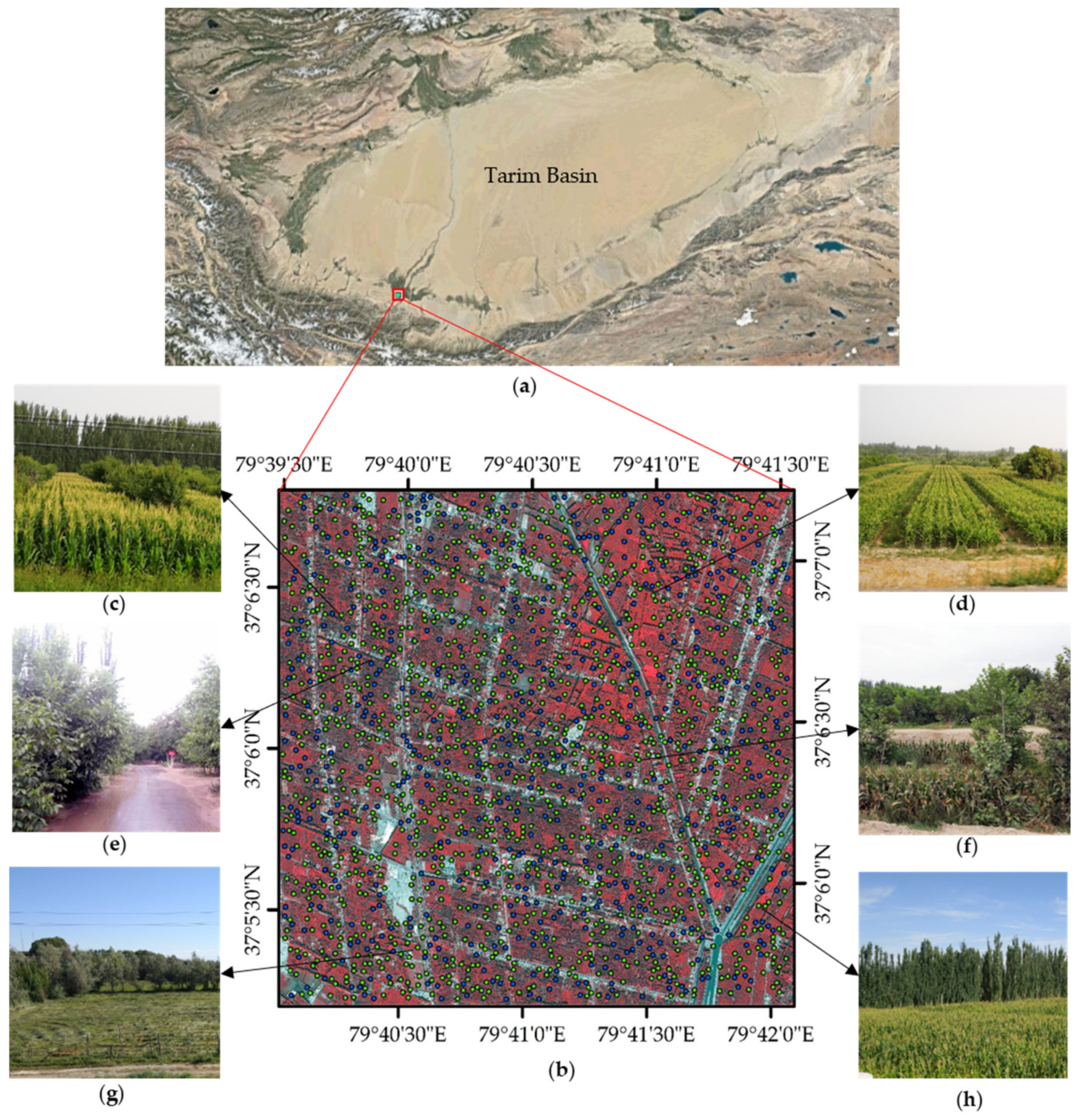
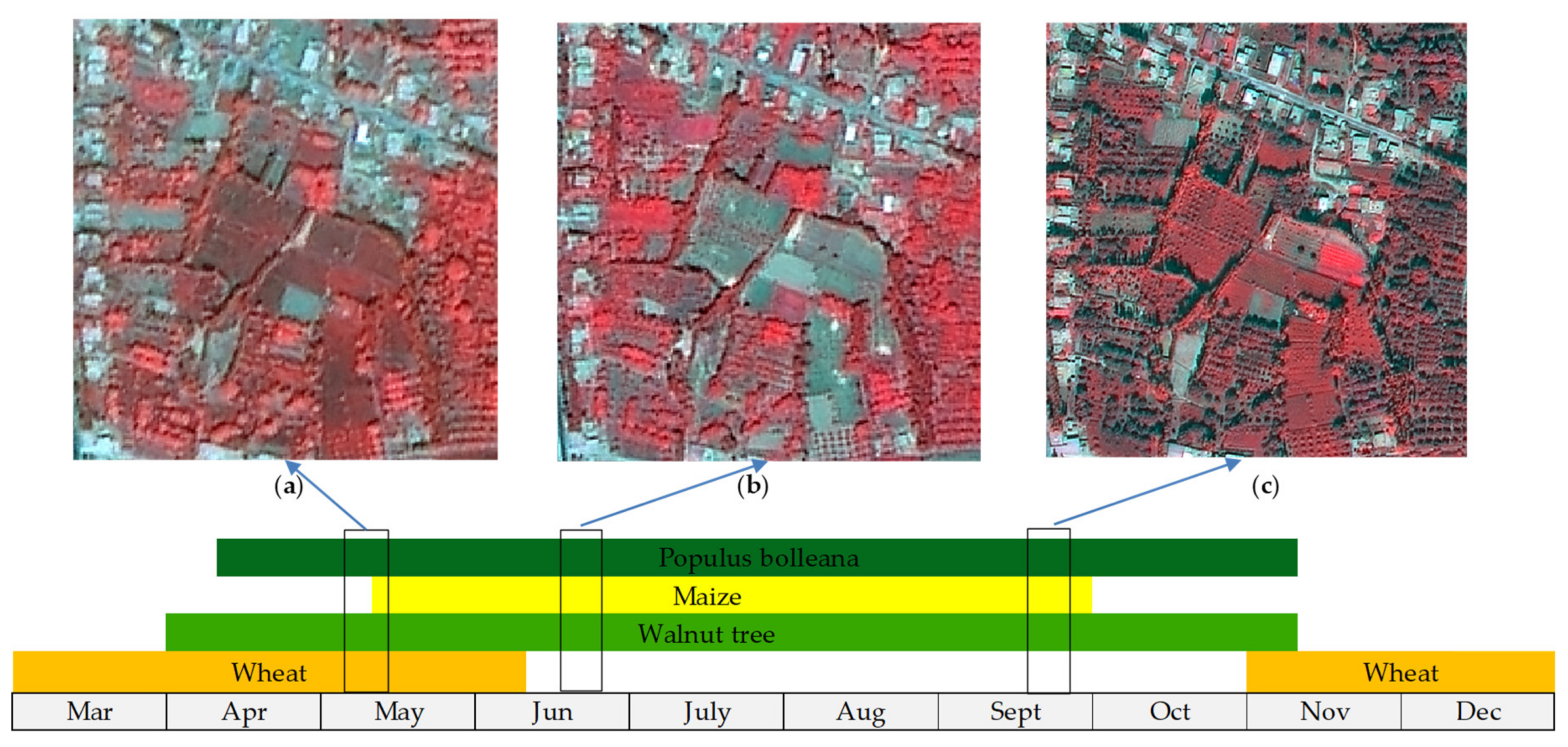
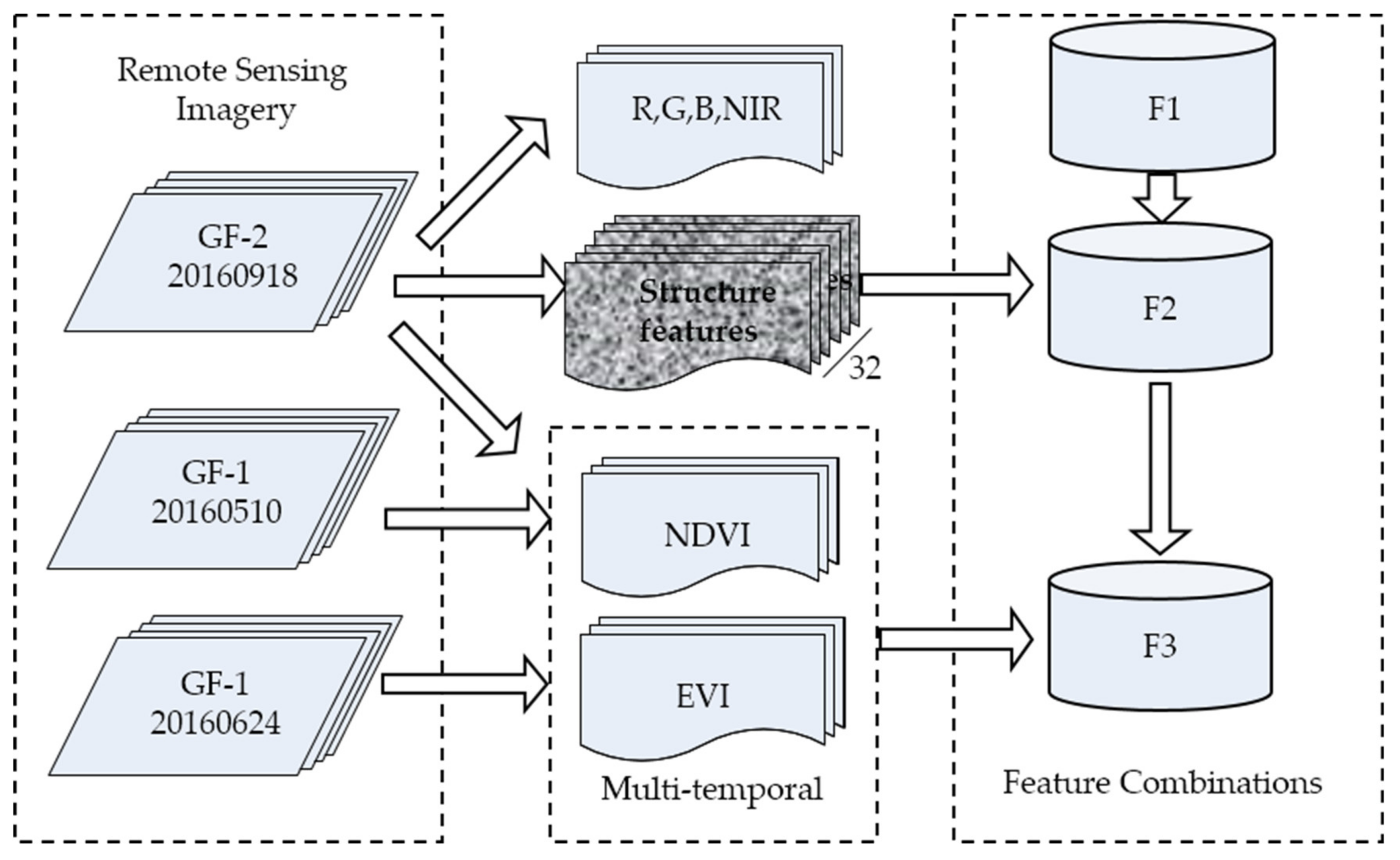
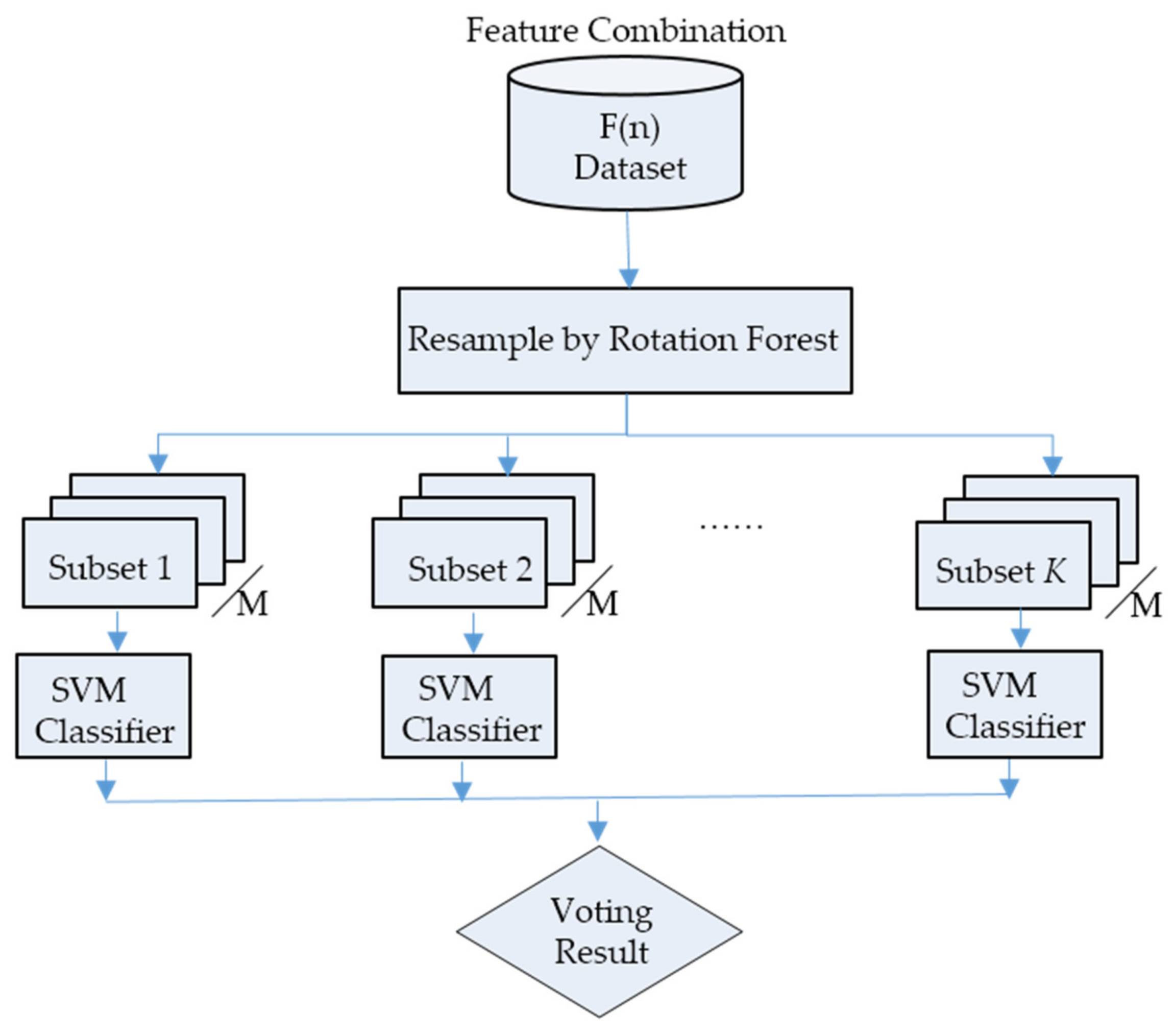
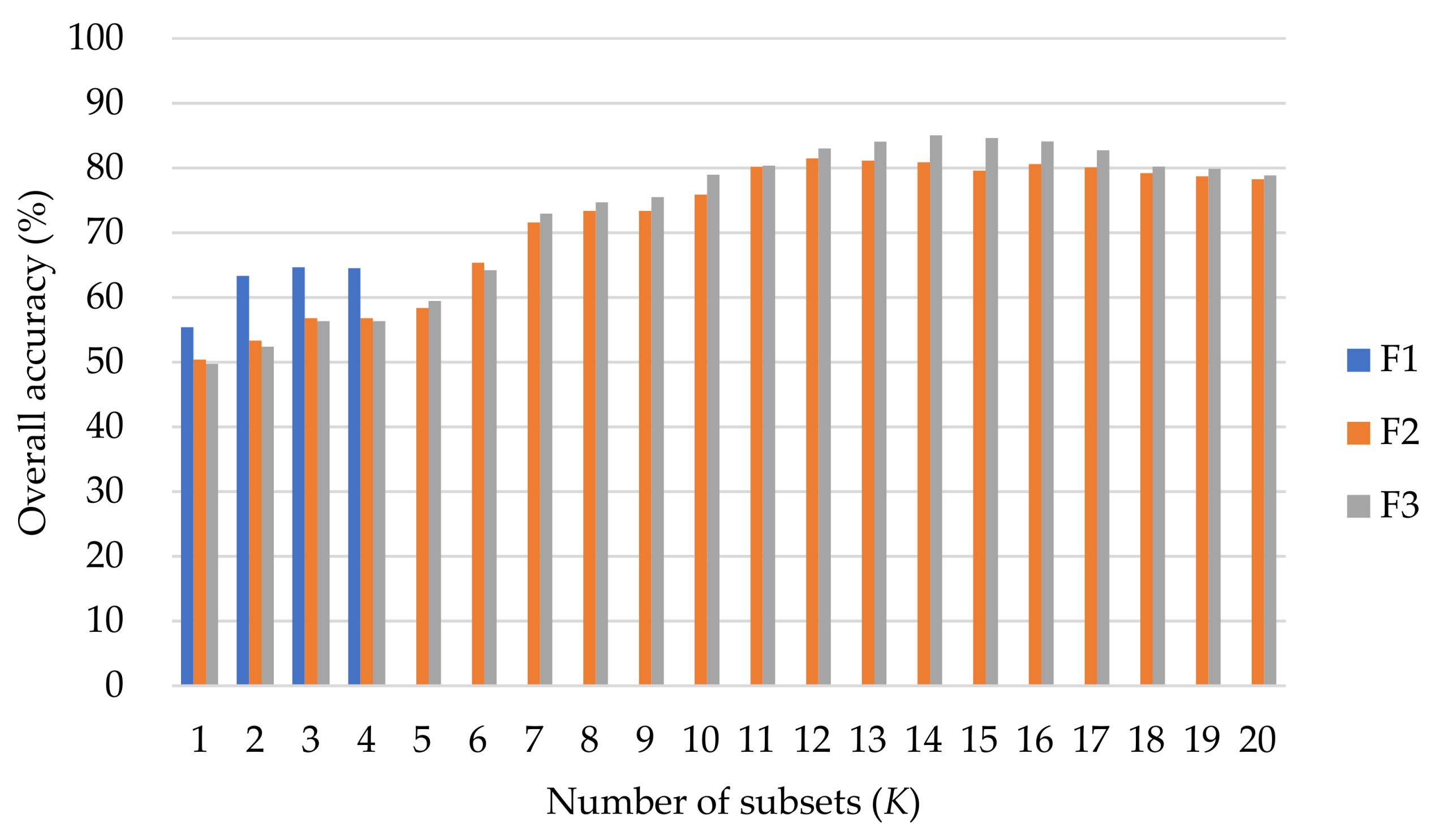
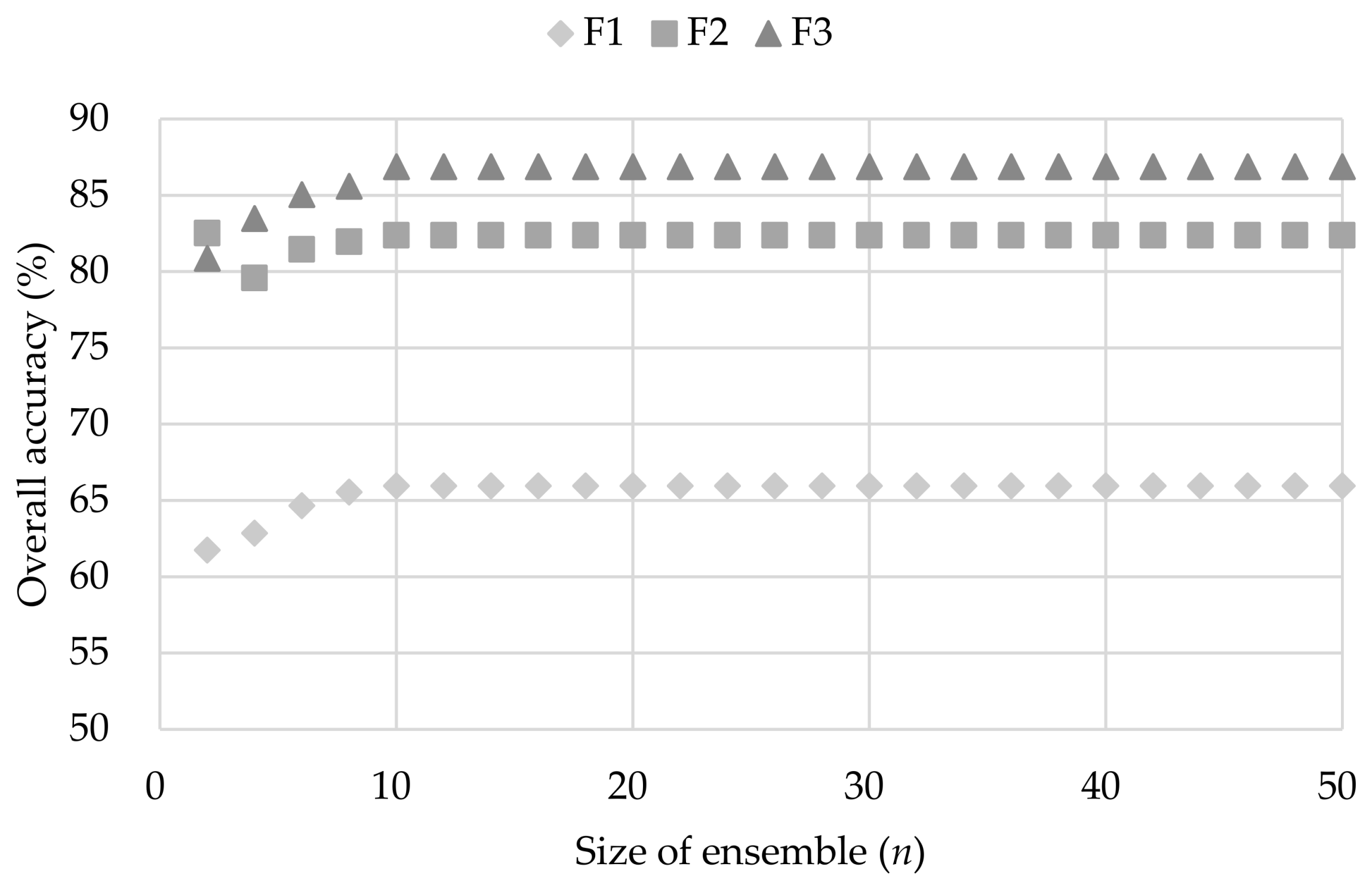
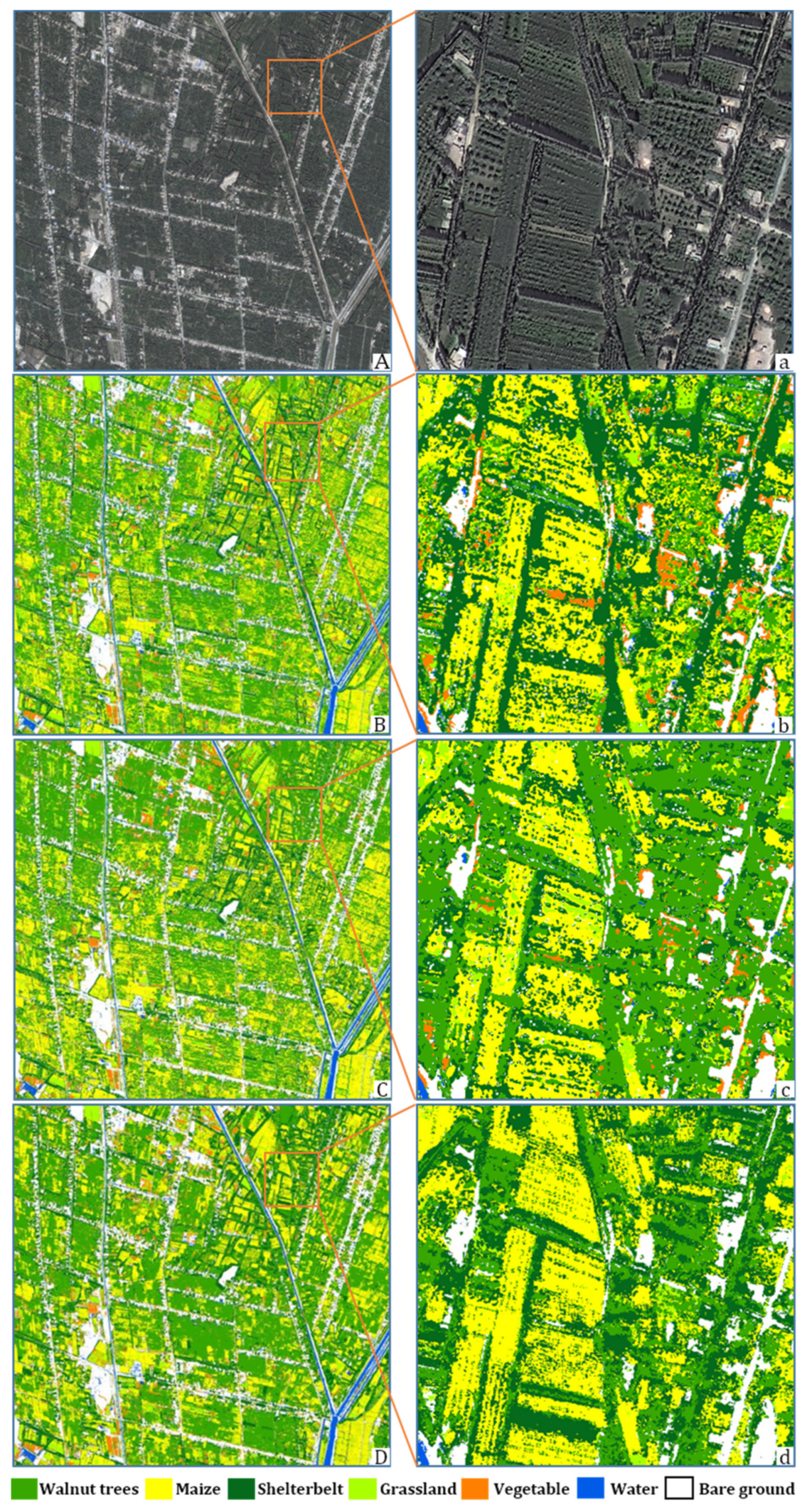
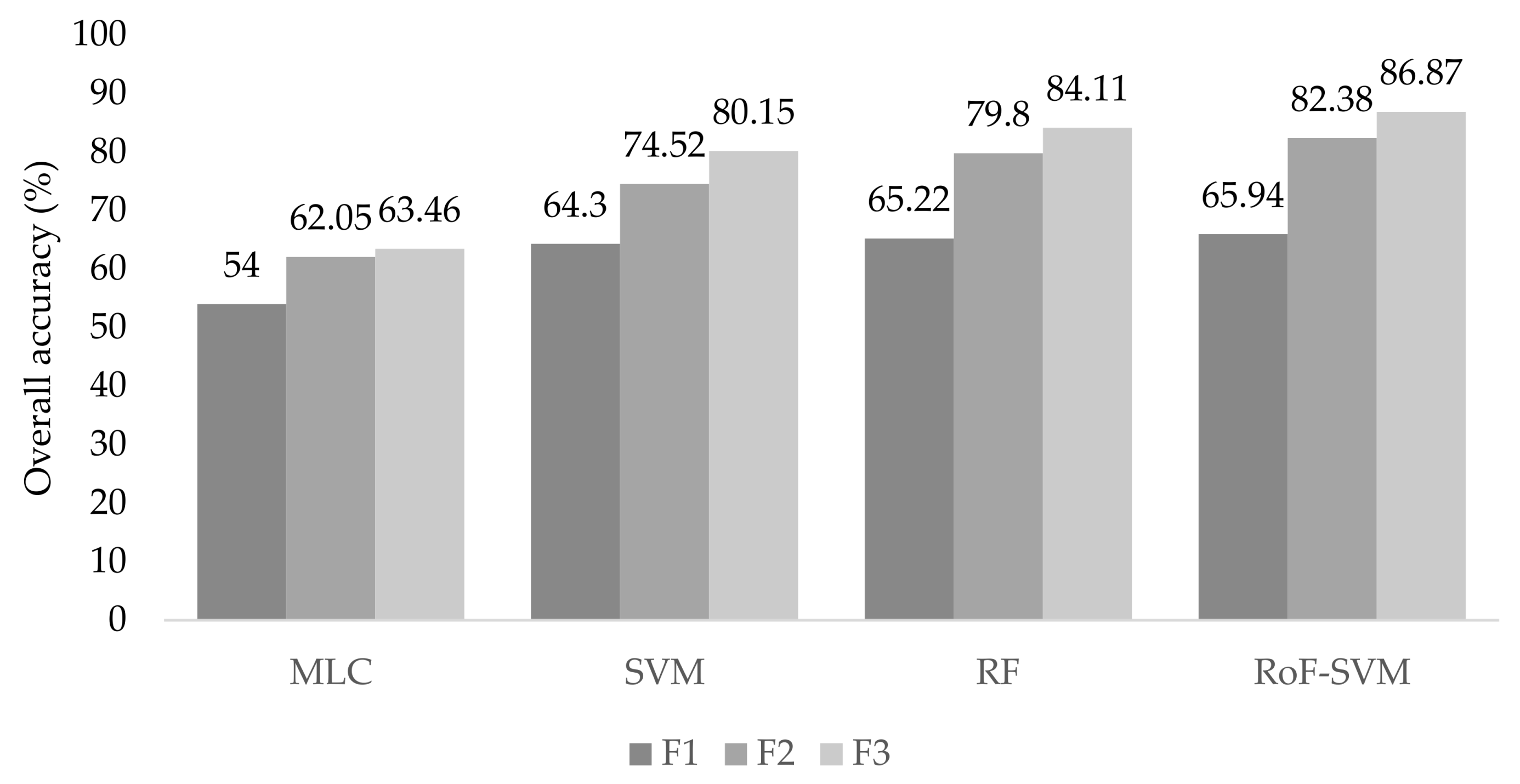
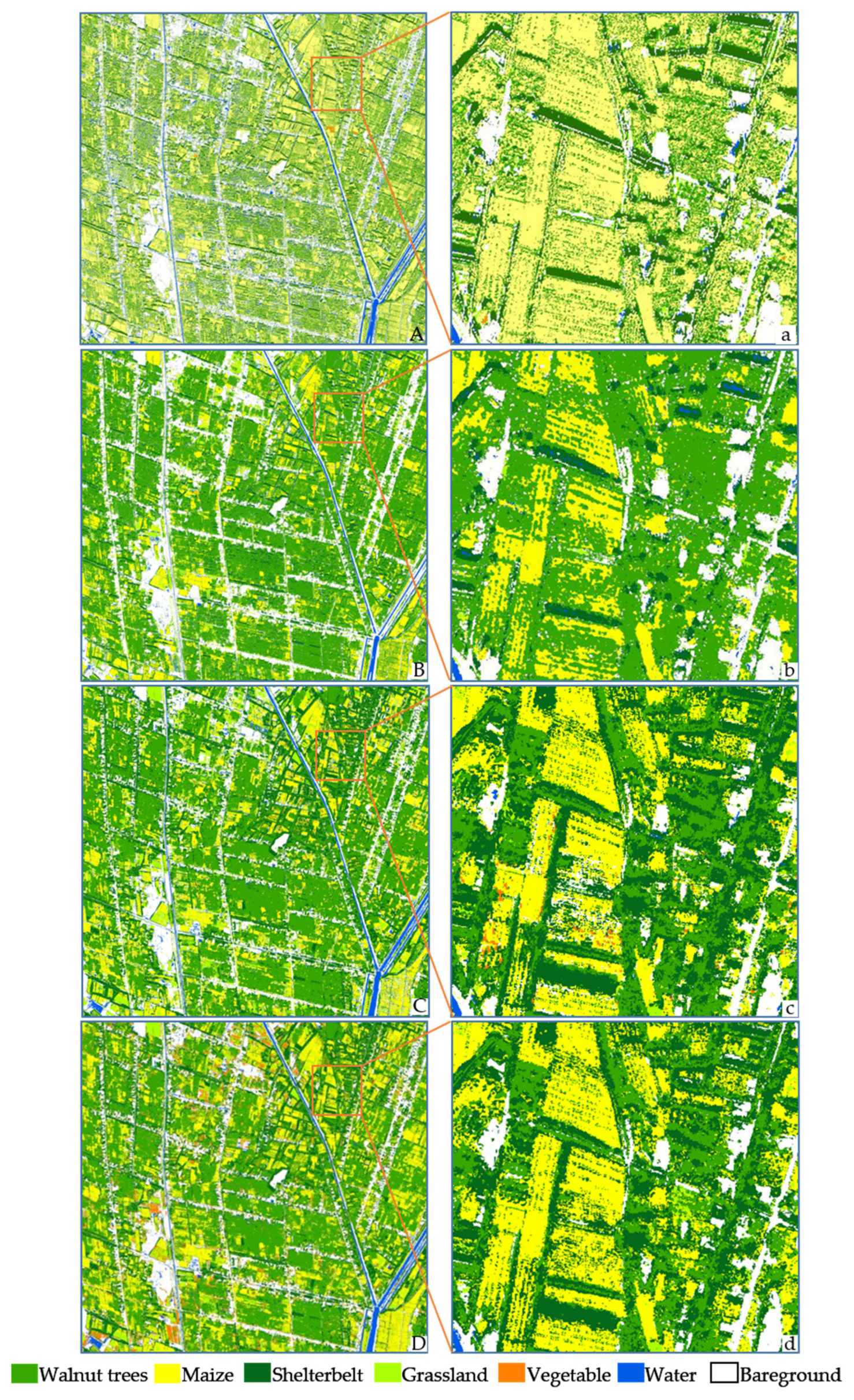
| Sensors | Band | Gain | Offset |
|---|---|---|---|
| GF-1 PMS1 | Pan | 0.1982 | 0 |
| Band1 | 0.232 | 0 | |
| Band2 | 0.187 | 0 | |
| Band3 | 0.1795 | 0 | |
| Band4 | 0.196 | 0 | |
| GF-1 PMS2 | Pan | 0.1979 | 0 |
| Band1 | 0.224 | 0 | |
| Band2 | 0.1851 | 0 | |
| Band3 | 0.1793 | 0 | |
| Band4 | 0.1863 | 0 | |
| GF-2 PMS2 | Pan | 0.1863 | 0 |
| Band1 | 0.1762 | 0 | |
| Band2 | 0.1856 | 0 | |
| Band3 | 0.1754 | 0 | |
| Band4 | 0.1980 | 0 |
| ID | Feature | ID | Feature | ID | Feature |
|---|---|---|---|---|---|
| 1 | Band1 | 15 | Homogeneity-2 | 29 | Mean value-44 |
| 2 | Band2 | 16 | Contrast-2 | 30 | Variance-4 |
| 3 | Band3 | 17 | Dissimilarity-2 | 31 | Homogeneity-4 |
| 4 | Band4 | 18 | Entropy-2 | 32 | Contrast-4 |
| 5 | Mean value-11 | 19 | Second Moment-2 | 33 | Dissimilarity-4 |
| 6 | Variance-1 | 20 | Correlation-2 | 34 | Entropy-4 |
| 7 | Homogeneity-1 | 21 | Mean value-3 | 35 | Second Moment-4 |
| 8 | Contrast-1 | 22 | Variance-3 | 36 | Correlation-4 |
| 9 | Dissimilarity-1 | 23 | Homogeneity-33 | 37 | NDVI-201605105 |
| 10 | Entropy-1 | 24 | Contrast-3 | 38 | NDVI-20160624 |
| 11 | Second Moment-1 | 25 | Dissimilarity-3 | 39 | NDVI-20160918 |
| 12 | Correlation-1 | 26 | Entropy-3 | 40 | EVI-201605105 |
| 13 | Mean value-22 | 27 | Second Moment-3 | 41 | EVI-20160624 |
| 14 | Variance-2 | 28 | Correlation-3 | 42 | EVI-20160918 |
| Feature Combination | Land Cover Type | User’s Accuracy | Producer’s Accuracy | Overall Accuracy | Kappa Coefficient |
|---|---|---|---|---|---|
| F1 | Walnut trees | 55.36 | 57.72 | 65.94 | 0.61 |
| Maize | 68.08 | 73.1 | |||
| Shelterbelt | 57.84 | 62.49 | |||
| Grassland | 60.61 | 57.62 | |||
| Vegetable | 68.42 | 63.72 | |||
| Water | 92.76 | 87.35 | |||
| Bare ground | 62.45 | 59.32 | |||
| F2 | Walnut trees | 72.26 | 71.68 | 82.38 | 0.73 |
| Maize | 83.11 | 86.96 | |||
| Shelterbelt | 74.22 | 83.74 | |||
| Grassland | 80.08 | 80.32 | |||
| Vegetable | 85.82 | 78.96 | |||
| Water | 97.06 | 90.16 | |||
| Bare ground | 89.67 | 89.8 | |||
| F3 | Walnut trees | 78.11 | 74.61 | 86.87 | 0.78 |
| Maize | 87.57 | 89.84 | |||
| Shelterbelt | 82.58 | 87.14 | |||
| Grassland | 83.74 | 86.83 | |||
| Vegetable | 86.24 | 82.76 | |||
| Water | 99.65 | 94.93 | |||
| Bare ground | 92.97 | 90.47 |
| Classification Method | Land Cover Type | User’s Accuracy (%) | Producer’s Accuracy (%) | Overall Accuracy (%) | Kappa Coefficient |
|---|---|---|---|---|---|
| MLC | Walnut trees | 51. 46 | 56.91 | 63.46 | 0.61 |
| Maize | 62.33 | 71.12 | |||
| Shelterbelt | 54.05 | 60.64 | |||
| Grassland | 57.93 | 55.61 | |||
| Vegetable | 66.85 | 61.01 | |||
| Water | 89.86 | 80.21 | |||
| Bare ground | 65.36 | 56.03 | |||
| SVM | Walnut trees | 70.19 | 69.19 | 80.15 | 0.72 |
| Maize | 81.56 | 84.73 | |||
| Shelterbelt | 76.35 | 80.24 | |||
| Grassland | 78.48 | 82.02 | |||
| Vegetable | 79.64 | 76.93 | |||
| Water | 93.35 | 89.56 | |||
| Bare ground | 88.12 | 86.4 | |||
| RF | Walnut trees | 74.62 | 73.17 | 84.11 | 0.76 |
| Maize | 84.43 | 88.75 | |||
| Shelterbelt | 83.01 | 87.07 | |||
| Grassland | 83.52 | 85.24 | |||
| Vegetable | 82.31 | 79.66 | |||
| Water | 98.86 | 94.8 | |||
| Bare ground | 93.2 | 91.1 | |||
| RoF-SVM | Walnut trees | 78.11 | 74.61 | 86.87 | 0.78 |
| Maize | 87.57 | 89.84 | |||
| Shelterbelt | 82.58 | 87.14 | |||
| Grassland | 83.74 | 86.83 | |||
| Vegetable | 86.24 | 82.76 | |||
| Water | 99.65 | 94.93 | |||
| Bare ground | 92.97 | 90.47 |
© 2019 by the authors. Licensee MDPI, Basel, Switzerland. This article is an open access article distributed under the terms and conditions of the Creative Commons Attribution (CC BY) license (http://creativecommons.org/licenses/by/4.0/).
Share and Cite
Liu, P.; Chen, X. Intercropping Classification From GF-1 and GF-2 Satellite Imagery Using a Rotation Forest Based on an SVM. ISPRS Int. J. Geo-Inf. 2019, 8, 86. https://doi.org/10.3390/ijgi8020086
Liu P, Chen X. Intercropping Classification From GF-1 and GF-2 Satellite Imagery Using a Rotation Forest Based on an SVM. ISPRS International Journal of Geo-Information. 2019; 8(2):86. https://doi.org/10.3390/ijgi8020086
Chicago/Turabian StyleLiu, Ping, and Xi Chen. 2019. "Intercropping Classification From GF-1 and GF-2 Satellite Imagery Using a Rotation Forest Based on an SVM" ISPRS International Journal of Geo-Information 8, no. 2: 86. https://doi.org/10.3390/ijgi8020086
APA StyleLiu, P., & Chen, X. (2019). Intercropping Classification From GF-1 and GF-2 Satellite Imagery Using a Rotation Forest Based on an SVM. ISPRS International Journal of Geo-Information, 8(2), 86. https://doi.org/10.3390/ijgi8020086




